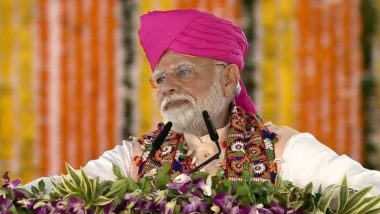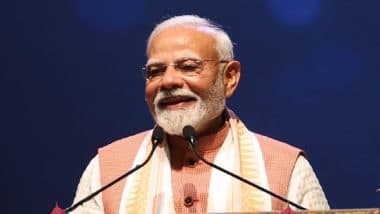Ahmedabad, Oct 7: The BJP's week-long celebration, ‘Vikas Saptah’, to mark 23 years of continuous governance in Gujarat under Prime Minister Narendra Modi's guidance commenced on Monday. The celebration reflects Gujarat's ongoing commitment to recognising the transformation of the state under the leadership of Prime Minister Narendra Modi, who served as Gujarat’s Chief Minister from 2001 to 2014. Under the BJP's leadership, Gujarat has undergone a period of rapid industrialisation, infrastructural growth, and socio-economic transformation, and this year’s celebrations aim to highlight these accomplishments.
The BJP’s journey in Gujarat began well before 2001, but Narendra Modi’s rise to power as the Chief Minister catalyzed a period of swift and sustained development. Narendra Modi was sworn in as Gujarat’s 14th Chief Minister on October 7, 2001, taking the reins of a state still recovering from the aftermath of the devastating 2001 Bhuj earthquake. With the dual challenges of rebuilding and governance, (then) CM Modi quickly emerged as a leader focusing on reform, infrastructure, and economic growth. His administration’s ability to attract investments and improve infrastructure rapidly reshaped Gujarat’s future, making the state a development model in India. ‘Vikas Saptah’ Celebrations to Kick off from October 7-15 to Celebrate 23 Years of Leadership Under PM Modi.
The Early Years: Resilience and Reconstruction
One of the key aspects of Narendra Modi’s early years as Chief Minister was his approach to recovery following the Bhuj earthquake, which had left the state reeling. His government prioritised reconstructing damaged infrastructure, particularly in rural Gujarat, where the quake's effects were most devastating. His administration's use of public-private partnerships played a crucial role in rebuilding the economy and restoring public confidence.
Additionally, he introduced policies to streamline government processes, focusing on transparency and efficiency. These reforms helped transform Gujarat into one of India’s most industrialised states. In an interview, he stated that emphasizing "speed, skill, and scale" became his guiding mantra as the Chief Minister. This pragmatic approach laid the foundation for his government’s pro-business stance, which would become a hallmark of the BJP’s governance in Gujarat.
Perhaps one of the most defining moments of Modi’s leadership in Gujarat was the introduction of the Vibrant Gujarat Global Investor Summit in 2003. This biennial event aimed to attract both domestic and foreign investment to Gujarat, and over time, it positioned Gujarat as one of India’s most industrialised states. Under Modi’s leadership, Gujarat became home to some of the largest companies in sectors like petrochemicals, automotive manufacturing, and pharmaceuticals. The state’s ease of doing business and investor-friendly policies attracted major firms like Tata, Suzuki, and Adani to establish operations in Gujarat.
The success of the Vibrant Gujarat Summits, which were held even after Narendra Modi departed for national politics, cannot be overstated. These summits drew billions of dollars in investment, allowing the state to grow its industrial capacity and create jobs for millions. By 2020, Gujarat accounted for nearly 16 per cent of India’s total industrial output. PM Narendra Modi Meets Maldives President Mohamed Muizzu at Hyderabad House for Discussions on Strengthening Bilateral Ties (See Pics and Watch Video).
While Modi’s tenure as Gujarat CM is often remembered for its focus on industrial growth, the Sujalam Sufalam water management project stands as one of his most impactful legacies in rural Gujarat. Launched in 2003, this programme aimed to conserve water through irrigation projects, check dams, and river interlinking, benefiting farmers who had long struggled with water scarcity.
Moreover, the BJP government promoted agricultural diversification, focusing on horticulture and dairy farming. As a result, Gujarat saw an agricultural growth rate of over 10 per cent during his tenure, even in the face of national agrarian crises. His efforts to reform agriculture included boosting rural infrastructure, creating markets for produce, and expanding the reach of micro-irrigation systems. These reforms helped Gujarat become a model state for agricultural productivity and sustainability.
Under Narendra Modi, Gujarat became a leader in renewable energy production, particularly in the solar energy sector. The Charanka Solar Park, one of the largest solar parks in Asia, was established during this period and is seen as a landmark achievement in renewable energy production. Modi’s government also focused on expanding the state’s power grid, making Gujarat one of the few states in India to achieve near 24-hour electricity in both urban and rural areas.
Urban development also took centre stage during Narendra Modi’s tenure as CM. Initiatives like the Sabarmati Riverfront Project and the development of GIFT City as a global financial hub placed Gujarat on the global map for urban innovation. The Ahmedabad Metro and Bus Rapid Transit System (BRTS) revolutionised urban transportation, improving connectivity and reducing traffic congestion in Gujarat’s rapidly growing cities. PM Narendra Modi Writes Garba Song ‘Aavati Kalay’ to Pay Tribute to Goddess Durga, Watch and Listen It Here (Video).
BJP’s Social Welfare Initiatives
Alongside economic and infrastructural development, the BJP also launched numerous social welfare initiatives to improve health, education, and quality of life in Gujarat. Programmes like the Kanya Kelavani scheme, which promoted girls' education, and the Jyotigram Yojana, which provided 24-hour electricity to villages, impacted the state’s rural population. The government’s focus on improving public healthcare led to the establishment of several public hospitals and healthcare centres, though the state still faces challenges in this sector.
Narendra Modi’s tenure as CM also saw focus on women’s empowerment. The Mission Mangalam initiative aimed to empower rural women through self-help groups, providing them with micro-finance opportunities and a pathway to economic independence.
Vikas Saptah: Celebrating 23 Years of Development
The announcement of Vikas Saptah (Development Week) highlights the BJP’s work in recognising Gujarat’s journey over the last two decades. The week-long celebrations will feature the inauguration and foundation stone-laying ceremonies for developmental projects worth Rs 3,500 crore, showcasing the state’s ongoing development.
The Vikas Padyatra, a march to be held at 23 iconic locations, including the Statue of Unity, Modhera Sun Temple, and iCREATE, will celebrate Gujarat’s achievements in industrialisation, tourism, and renewable energy. The celebrations will also include cultural performances, art installations, and exhibitions, reflecting on the state’s evolution. ubbed-from-best-male-playback-singer-nominations-6704888.html" class="drop-thumb-link" title="Sonu Nigam Slams 2025 IIFA After Being Snubbed From Best Male Playback Singer Nominations">Sonu Nigam Slams 2025 IIFA After Being Snubbed From Best Male Playback Singer Nominations













 Quickly
Quickly











 PM Narendra Modi Meets Maldives President Mohamed Muizzu at Hyderabad House for Discussions on Strengthening Bilateral Ties (See Pics and Watch Video).
PM Narendra Modi Meets Maldives President Mohamed Muizzu at Hyderabad House for Discussions on Strengthening Bilateral Ties (See Pics and Watch Video).








